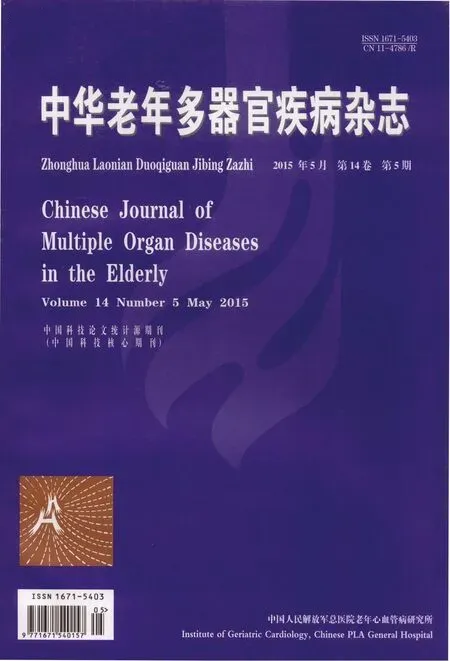不同麻醉药物对老年非体外循环冠状动脉旁路移植术患者血清兴奋性氨基酸的影响
2015-04-21张铁峰柴金花蒋海斌
张铁峰,柴金花,李 颖,蒋海斌
不同麻醉药物对老年非体外循环冠状动脉旁路移植术患者血清兴奋性氨基酸的影响
张铁峰,柴金花,李 颖,蒋海斌*
(兰州市第一人民医院麻醉科,兰州 730050)
比较不同麻醉药对老年非体外循环冠状动脉旁路移植术患者血清兴奋性氨基酸(EAA)的影响。择期行非体外循环冠状动脉旁路移植术的患者120例,年龄60~75岁,ASA(美国麻醉医师协会)Ⅱ或Ⅲ级,随机分为丙泊酚复合瑞芬太尼组(P组)和七氟烷(S组),每组60例。P组丙泊酚复合瑞芬太尼,S组吸入七氟烷维持麻醉。分别于麻醉前(T0)、术毕即刻(T1)、术后24h(T2)、48h(T3)、72h(T4)从颈内静脉采血2ml,采用反相高效液相色谱荧光法检测血清中EAA浓度。组内比较T2、T3两组血清谷氨酸(Glu)、天冬氨酸(Asp)、甘氨酸(Gly)浓度与麻醉前均有不同程度升高(<0.05);与P组比较S组Glu、Asp、Gly浓度在T2明显升高(<0.05),Glu浓度在T3明显升高(<0.05),T1和T4Glu、Asp、Gly浓度与P组比较,差异无统计学意义(>0.05)。非体外循环冠脉搭桥术老年患者应用丙泊酚复合瑞芬太尼麻醉,可降低血清EAA浓度,有减少术后认知功能障碍的趋势。
认知障碍;非体外循环;冠状动脉分流术;氨基酸类;老年人
认知功能障碍是一类严重影响中老年人身心健康和生活质量的疾病,随着我国进入老龄社会,其发病率逐年增加。术后认知功能障碍(postoperative cognitive dysfunction,POCD)是指手术麻醉后患者出现定向、记忆、思维、自知力等中枢神经功能改变。POCD是全身麻醉手术后常见并发症之一[1],有效防治认知功能障碍已成为一个刻不容缓的问题。
老年人本身中枢神经系统功能减退,这使得老龄成为记忆障碍的危险因素和长期因素,老年患者全麻术后血清兴奋性氨基酸(excitatory amino acids,EAA)水平维持较高水平可能是老年POCD发病率高的原因之一[2−3]。全麻药能够干预学习记忆的过程,引起记忆障碍,但不同麻醉药对认知的影响各异,七氟烷(sevoflurane)、异氟烷(isoflurane)和丙泊酚(propofol)均可阻断情绪记忆[4]。故不同的麻醉方法、不同的麻醉用药对老年患者血清EAA浓度有不同影响,从而为临床试验提供可行性。
1 对象与方法
1.1 对象
选择ASAⅡ或Ⅲ级择期非体外循环冠脉搭桥手术患者120例,其中男98例,女22例,年龄60~75岁,采用随机对照研究,查表法估算每组实际病例数不低于44例,区组随机分组分为丙泊酚复合瑞芬太尼(remifentanil)麻醉组(P组)60例和七氟烷麻醉组(S组)60例。排除冠状动脉单支病变、心脏瓣膜疾病,肝、肾功能衰竭,高血压、糖尿病患者术前未得到有效控制的病例和术前服用精神类药物及已知的能够影响血清中氨基酸的药物如雌激素,复方氨基酸等。
1.2 方法
1.2.1 麻醉方式、监测与管理 所有患者麻醉前30min肌肉内注射吗啡0.1~0.2mg/kg,东莨菪碱(hyoscine)0.3mg,术前β-受体阻滞药和硝酸甘油维持至术日晨。入室后常规监测心电图(electrocardiogram,ECG)、脉搏和血氧饱和度(oxygen saturation,SPO2)(惠普HEWLETT PACKARD,美国),局麻下行桡动脉穿刺监测动脉压。麻醉诱导采用咪达唑仑(midazolam)0.05~0.1mg/kg,维库溴铵(vecuronium bromide)0.1mg/kg,丙泊酚1~2mg/kg,舒芬太尼(sulfentanyl)1μg/kg。肌松后快速气管插管,连接麻醉机(Drager Fabius美国)机械通气,维持潮气量8~10ml/kg,呼吸频率10~12次/min,氧流量1.5L/min,呼吸末二氧化碳分压(end-tidal CO2,ETCO2)35~45mmHg(1mmHg=0.133kPa)行颈内静脉穿刺置管监测中心静脉压(central venous pressure,CVP),放置尿管监测尿量。麻醉维持P组用丙泊酚1~3mg/(kg·h)和瑞芬太尼6~10μg/(kg·h)持续泵入。S组吸入七氟烷(批号:5Y18,Abbott公司,美国),呼气末浓度1.0%~1.5%。两组均使用维库溴铵0.07mg/kg,每小时追加1次,脑电双频指数(bispectral index,BIS)值40~50之间。术中经中心静脉持续泵注硝酸甘油0.3~0.5[μg/(kg·min)]。维持血压、心率(heart rate,HR)稳定,如收缩压(systolic blood pressure,SBP)>140mmHg(高血压患者SBP>160mmHg)持续>3min,则静注尼卡地平(nicardipine)0.3~0.5mg,如SBP<80mmHg持续>3min则静注苯肾上腺素30~50ug;如HR>90次/min,则静注艾司洛尔(esmolol)每次20~30mg,HR<50次/min,静注阿托品(atropine)0.3~0.5mg。术中输注乳酸钠林格氏液(sodium lactate ringer)和羟乙基淀粉(hetastarch)注射液,根据术中出血量的多少,适当成分输血。切开心包后给肝素1mg/kg,保持激活凝血时间>300s,术毕用鱼精蛋白(nucleoprotamine)拮抗,术后患者送ICU病房。
1.2.2 样本采集与测定 麻醉前经右颈内静脉球部穿刺置管用于采血样,分别于麻醉前(T0)、术毕即刻(T1)、术后24h(T2)、48h(T3)、72h(T4)空腹采血2ml,肝素抗凝,3 000 转/min离心15min分离血浆,取血浆1ml加入50%磺基水杨酸100μl,混匀后以15 000转/min,4℃离心20min,取上清液经0.122μm微孔滤膜过滤,去除蛋白质,过滤液置-80℃冰箱保存待测。采用反相高效液相色谱荧光法检测血清中EAA浓度。
1.2.3 仪器和试剂 高效液相色谱仪(日本Shimadzu公司);荧光检测器(美国Varian公司);C18色谱分析柱(日本Shimadzu公司);氨基酸标准品(上海化学试剂公司):谷氨酸(glutamic acid,Glu)、天冬氨酸(asparagic acid,Asp)、甘氨酸(glycine,Gly);邻苯二甲醛(O-phthalaldehyde,OPA)、β-二巯基乙醇(β-Mercaptoethanol,2-MCE,美国AMRESCO公司)。
1.3 统计学处理

2 结 果
两组患者性别构成分别为:P组男50人,女10人;S组男48人,女12人。两组患者的年龄、体质量、性别构成比、美国麻醉医师协会(American Society of Anesthesiologists,ASA)分级、左室射血分数、术后拔管时间、手术时间比较,差异无统计学意义(>0.05,表1)。

表1 两组患者一般情况及术中相关指标比较
P: propofol and remifentanil; S: sevoflurane; BM: body mass; ASA: American Society of Anesthesiologists; LVEF: left ventricular ejection fraction
所选病例全部完成手术过程。手术均为二支或三支血管搭桥,出血量均少于300ml。术后再无使用镇静药物,且手术均为同一组医师完成。
血清EAA浓度比较:术后24h、48h两组血清Glu、Asp、Gly浓度与麻醉前均有不同程度升高(<0.05),术后72h两组血清Glu、Asp、Gly浓度与麻醉前比较,差异无统计学意义(>0.05);与P组比较,S组Glu、Asp、Gly浓度在术后24h明显升高(<0.05),Glu浓度在术后48h明显升高(<0.05),术毕即刻和术后72h Glu、Asp、Gly浓度与P组比较,差异无统计学意义(>0.05,表2)。组内比较术前及术后72h结果比较无差异,可能是术前无用药,而术后72h药物高峰期已过。
3 讨 论
脑脊液可直接地反应脑组织EAA水平,但因为蛛网膜下腔穿刺是有创性的且易引起并发症,而颈内静脉血液也可准确地反映脑组织情况,故也常被用作脑研究指标的采集标本。EAA在脑细胞间隙过度聚集是脑缺血、脑损伤后迟发性神经细胞功能损害发生的重要病理生理基础。
许多研究[5−7]证实,EAA在神经元缺血性损伤中起重要作用,老年患者全麻术后颅内EAA水平的升高可能参与了POCD发生的病理生理过程[8]。Rasmussen等[9]提出POCD的发生可能与全麻药物对EAA升高有关。EAA(主要为Asp和Glu)是脑内含量最高的氨基酸。颅内过量的Asp和Glu对中枢神经系统具有兴奋性神经毒性作用,主要是激活突触后膜的N−甲基−D−天门冬氨酸(N-methyl-D-as-partate,NMDA),使胞外Na+、Ca2+大量内流,造成神经细胞急性渗透性损害和迟发性神经元坏死。Glu在突触稳定性的维持及可塑性变化中起关键作用,能够调节学习记忆。兴奋性Glu受体也是麻醉药影响记忆障碍的重要靶点[10]。本研究从麻醉药对EAA变化的角度阐述其对患者认知功能障碍的影响。
虽然Gly是抑制性氨基酸,并非EAA成员,但却是NMDA受体的协同激动剂,因NMDA受体复合体中有与Gly结合的亚基,所以Gly升高也提示兴奋性毒性增加。Gly通过调节激动NMDA受体影响离子通道,增加Ca2+内流,其释放增加能扩大脑缺血损害。Saransaari等[11]用伪拮抗剂利鲁唑(riluzole tablets)治疗脑缺血损伤大鼠,发现Gly含量减少,而损伤效应减轻。
丙泊酚可对抗自由基氧化,减少体外培养神经突触体释放EAA,有减轻脑缺血再灌注后的脑细胞水肿、形态学损伤和脑神经功能损害的作用。有研究表明,丙泊酚对氨基酸类神经递质含量的调节是其产生全麻作用的重要因素[12]。丙泊酚可明显上调下丘脑、海马和顶叶氨基酸转运体2(excitatory amino acid transporter 2,EAAT2)mRNA的表达[13],EAAT2是位于细胞膜的兴奋性氨基酸最主要的转运体。
本研究结果显示,两组患者在麻醉后EAA都有不同程度的升高,72h后和术前无明显变化,提示两组患者在麻醉后都可造成中枢神经系统毒性损伤。但与S组比较,P组在麻醉24h血清EAA浓度明显降低,48h血清Glu浓度明显降低,说明S组中枢神经系统毒性损伤程度低于P组。

表2 两组患者血清Glu、Asp、Gly浓度的比较
S: sevoflurane; P: propofol and remifentanil; T0: before anaesthesia; T1: immediately after surgery; T2: at 24h after surgery; T3: at 48h after surgery; T4: at 72h after surgery; Glu: glutamic acid; Asp: asparagic acid; Gly: glycine. Compared with before the anaesthesia,*<0.05,**<0.01; compared with group P,#<0.05
许德奖等[14]收集归纳国内外关于丙泊酚、七氟烷、异氟烷等吸入性麻醉药对老年患者非心脏手术后早期认知功能障碍影响的13篇文献进行Meta分析,结果显示,丙泊酚静脉麻醉比气体麻醉后老年患者术后血清EAA浓度低,与本研究结果一致。
综上所述,非体外循环冠脉搭桥术老年患者应用丙泊酚复合瑞芬太尼麻醉,与七氟烷麻醉比较,该方法可降低血清EAA浓度,从而可能减少POCD的趋势。
[1] Li X, Wen DX, Chen J,. Multi-center clinical study on morbidity and related factors of postoperative mental and cognitive disorder in the elderly[J]. J Clin Anesthesiol, 2009, 25(8): 652−654. [李 兴, 闻大翔, 陈 杰, 等. 老年患者术后认知功能障碍发生率及相关因素的多中心研究[J]. 临床麻醉学杂志, 2009, 25(8): 652−654.]
[2] Deng YF, Xu YG, Huang JP. Relationship of postoperative cognitive dysfunction with perioperative serum excitatory amino acids content in elderly patients receiving non-heart operation[J]. Mod Pract Med, 2014, 26(7): 877−878. [邓迎丰, 徐义国, 黄建平. 老年患者非心脏手术术后认知功能障碍与围术期血清兴奋性氨基酸含量的关系[J]. 现代实用医学, 2014, 26(7): 877−878.]
[3] Feng CS, Yu QB, Yang D,. The relationship between serum levels of excitatory amino acids and postoperative cognitive function in elderly patients receiving prostate vaporization under different anesthesia methods[J]. Chin J Gerontol, 2013, 33(21): 5442−5443. [冯昌盛, 余庆波, 杨 丹, 等. 不同麻醉方式下老年前列腺汽化术患者血清兴奋性氨基酸水平与术后认知功能的关系[J]. 中国老年学杂志, 2013, 33(21): 5442−5443.]
[4] Alkire MT, Gruver R, Miller J,. Neuroimaging analysis of an anesthetic gas that blocks human emotional memory[J]. Proc Natl Acad Sci USA, 2008, 105(5): 1722−1727.
[5] Håberg A, Qu H, Saether O,. Differences in neurotransmitter synthesis and intermediary metabolism between glutamatergic and GABAergic neurons during 4 hours of middle cerebral artery occlusion in the rat: the role of astrocytes in neuronal survival[J]. J Cereb Blood Flow Metab, 2001, 21(12): 1451−1463.
[6] Meldrum BS. Glutamate as a neurotransmitter in the brain: review of physiology and pathology[J]. J Nutr, 2000, 130(4S Suppl): 10075S−10015S.
[7] Castillo J. Physiopathology of cerebral ischemia[J]. Rev Neurol, 2000, 30(5): 459−464.
[8] Shu SH, Fang C, Pan JH,. Relationship between intracranial excitatory aminoacid levels and postoperative cognitive dysfunction in elderly patients after general anesthesia[J]. Chin J Anesthesiol, 2010, 30(3): 290−293. [疏树华, 方 才, 潘建辉, 等. 老年病人全麻术后颅内兴奋性氨基酸水平与术后认知功能障碍的关系[J]. 中华麻醉学杂志, 2010, 30(3): 290−293.]
[9] Rasmussen LS, Steentoft A, Rasmussen H,. Benzodiazepines and postoperative cognitive dysfunction in the elderly. ISPOCD Group. International Study of Postoperative Cognitive Dysfunction[J]. Br J Anaesth, 1999, 83(4): 585−589.
[10] Rudolph U, Antkowiak B. Molecular and neuronal substrates for general anaesthetics[J]. Nat Rev Neurosci, 2004, 5(9): 709−720.
[11] Saransaari P, Oja SS. Characteristics of hippocampal glycine release in cell-damaging conditions in the adult and developing mouse[J]. Neurochem Res, 2001, 26(7): 845−852.
[12] Zhang H, Wang W, Gao W,. Effect of propofol on the levels of neurotransmitters in normal human brain: a magnetic resonance spectroscopy study[J]. Neurosci Lett, 2009, 467(3): 247−251.
[13] Li Y, Lin CS, Gu MN,. Effect of propofol at uptake equilibrium on excitatory amino acid transporter-2 mRNA expression in different brain regions in dogs[J]. J Pract Med, 2012, 28(21), 3524−3527. [李 洋, 林春水, 古妙宁, 等. 脑摄取平衡时丙泊酚对犬脑不同区域兴奋性氨基酸转运体2mRNA的影响[J]. 实用医学杂志, 2012, 28(21), 3524−3527.]
[14] Xu DJ, Yang W, Zhao GD. Effect of propofol and inhalation anesthesia on postoperative cognitive dysfunction in the elderly: a meta-analysis[J]. J South Med Univ, 2012, 32(11): 1623−1627. [许德奖, 杨 威, 赵国栋. 丙泊酚与气体麻醉对老年患者术后认知功能障碍的影响: Meta分析[J]. 南方医科大学学报, 2012, 32(11): 1623−1627.]
(编辑: 李菁竹)
Effects of different anaesthetics on serum excitatory amino acids in elderly patients undergoing off-pump coronary artery bypass grafting
ZHANG Tie-Feng, CHAI Jin-Hua, LI Ying, JIANG Hai-Bin*
(Department of Anesthesiology, the First People’s Hospital of Lanzhou, Lanzhou 730050, China)
To compared the effect of different anaesthetic drugs on the serum levels of excitatory amino acids (EAA) in the elderly undergoing off-pump coronary artery bypass grafting.One hundred and twenty patients at America Society of Anesthesiologist (ASA)Ⅱ orⅢand aged 60 to 75 years who undergoing selective off-pump coronary artery bypass grafting in our department were enrolled in this study. They were randomly divided into propofol and remifentanil group (group P) and sevoflurane (group S) (=60 for each group). Group P received propofol and remifentanil to maintain anesthesia, and group S inhaled sevoflurane at the end-tidal concentration of 1.0%~1.5% during anesthesia. Blood samples were harvested from the internal jugular vein before anesthesia (T0), immediately after surgery (T1), at 24h (T2), 48h (T3) and 72h (T4) after surgery. Reverse-phase high-performance liquid chromatography with fluorescence was used to measure serum EAA concentrations.The serum concentrations of glutamic acid (Glu), asparagic acid (Asp) and glycine (Gly) were significantly higher at T2, T3than at T0(<0.05). The concentrations were significantly higher at T2in group P than in group S (<0.05), and Glu concentrations was increased significantly at T3(<0.05). But there was no significant difference in the Glu, Asp, Gly concentrations at T1and T4between the 2 groups (>0.05).Anesthesia with propofol and remifentanil reduces the serum concentrations of EAA for the elderly undergoing off-pump coronary artery bypass, and thus protect them from postoperative cognitive dysfunction.
cognition disorders; off-pump; coronary artery bypass; amino acids; aged
R741.041; R654.33
A
10.11915/j.issn.1671-5403.2015.05.084
2014−12−09;
2015−02−14
蒋海斌, E-mail: lzjianghaibin@hotmail.com
